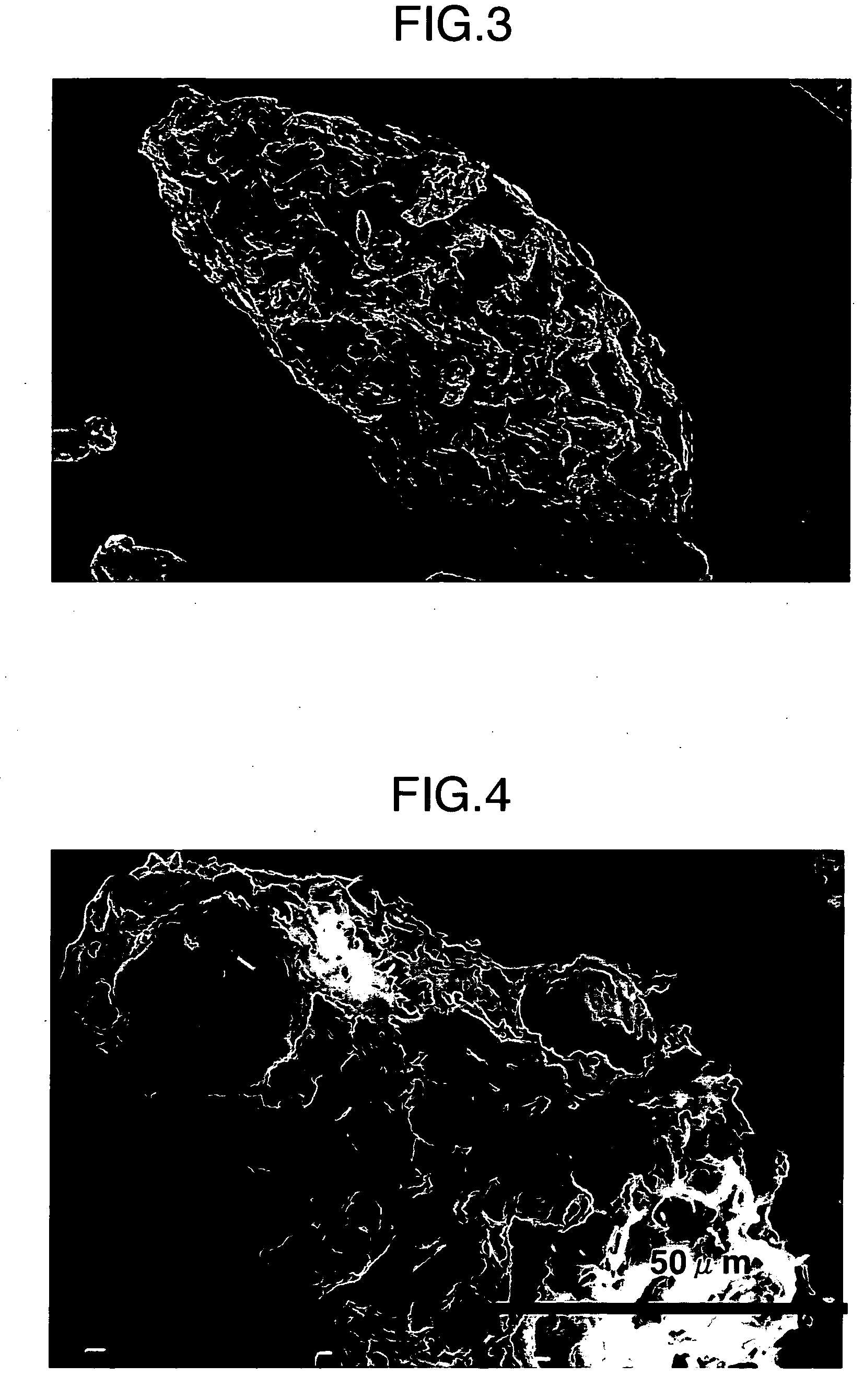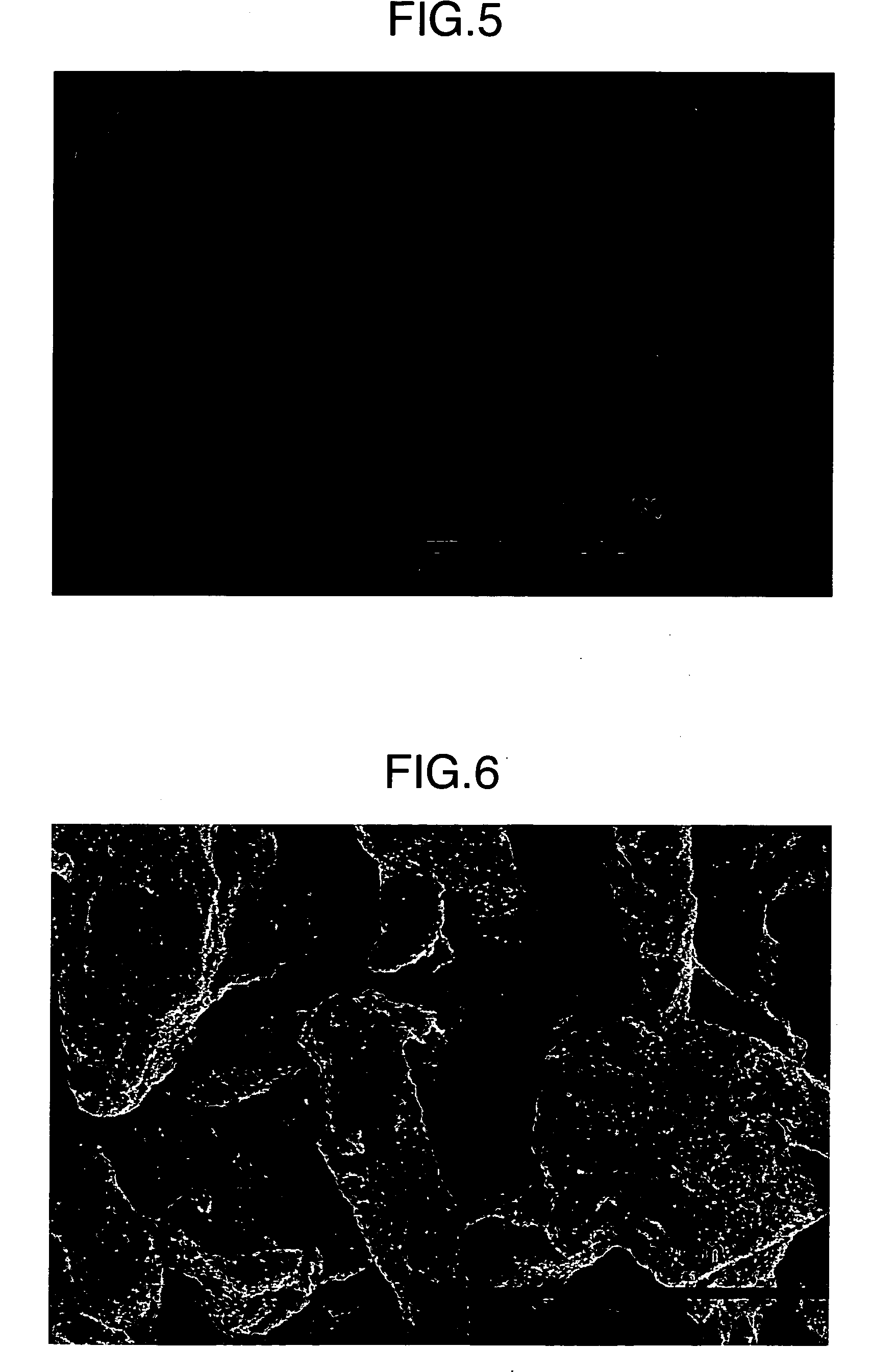Although the cellulose particles according to
Patent Document 1 are excellent in flowability, the dense and continuous cellulose wall has little water permeability and therefore they do not disintegrate in water, which may
pose a problem in quickly releasing the
active ingredient.
In addition, the cellulose particles according to
Patent Document 1 are poor in plastic deformation properties when the cellulose is compressed, the compactibility thereof is insufficient, and the use of an
organic solvent and a third ingredient such as a crystalline material soluble in an
organic solvent in the production process not only increases the production cost but also may deactivate the
active ingredient, and it is not sufficient to be stably used as an
excipient.
Furthermore, although the pore volume of the cellulose particle of Patent Document 2 is large in itself, water is hard to permeate into the particle because the particle structure is different from the porous cellulose aggregate of the present invention, and therefore it has a problem of poor disintegration property.
In addition, this porous cellulose aggregate particle uses an
organic solvent in the production process, which not only increases production cost but also results in too large specific surface area and may promote mutual action between the active ingredient and water and deactivate the active ingredient and therefore it was not sufficient to be stably used as an excipient.
These Patent Documents disclose controlling compactibility, flowability and disintegration property of the cellulose particles by adjusting the value of apparent
specific volume but there was a problem that when the apparent
specific volume was in a relatively
small range of 2.0-2.9 cm3 / g, compactibility was not satisfactory although flowability and disintegration property could be excellent whereas when the apparent
specific volume was in a slightly increased range of 3.0-3.2 cm3 / g, flowability and disintegration property deteriorated although compactibility was excellent.
Although this
glucan powder had a good compactibility, it had a problem that it was inferior in disintegration property.
In addition, it was poor in flowability because the average particle size was small.
There is a description that cellulose
powder of Patent Document 6 is excellent in compression compactibility and disintegration property, but when the repose angle of Examples having the most excellent balance as specifically disclosed was measured, it exceeded 55° and flowability was not sufficiently satisfied, and therefore there was a problem that the variation index of tablet weight became large in a formulation containing a large amount of active ingredient which was poor in flowability, and the homogeneity of the content of pharmacological agents was affected.
In addition, when the cellulose
powder of this document was molded under
high pressure, high
hardness could be provided but there arose a problem of delayed degradation since it had no intentionally formed pores within a particle and had little water permeability into the inside of the particle.
Therefore the flowability was not satisfied.
Furthermore, when the
cellulose powders described in these documents were molded under
high pressure, high
hardness could be provided but there arose a problem of delayed degradation since they had no intentionally formed pores within a particle and had little water permeability into the inside of the particle.
Although the
cellulose powders described in these Patent Documents 5-8 provide a sufficient compactibility as far as the apparent specific volume is in a range of 2.3-6.4 cm3 / g, they had a problem that flowability and disintegration property deteriorate.
The cellulose particles described in these publications do not take secondary aggregate structures and the cellulose particles obtained by the method described in these patent documents have an apparent specific volume of 2.5 cm3 / g or less, a shape near a sphere and an excellent flowability but they are inferior in compression compactibility and cannot be molded products having practically sufficient
hardness under a commonly used
compression pressure of 10-20 MPa.
In the meantime, since the cellulose particles described in Patent Documents 3-12 do not have intentionally formed pores within a particle and the volume of the pores within a particle is small, they can hardly carry an active ingredient within a particle and there were problems of liquid exudation at the time of compression shaping and troubles in
tableting.
On the other hand, the cellulose particles described in Patent Documents 1 and 2 have pores within a particle but due to small
pore diameter they had a problem that water is hard to permeate into the dense and continuous cellulose wall and therefore they do not disintegrate in water and may cause problems for rapid release of the active ingredient.
In addition, since these cellulose particles do not have intentionally formed pores within a particle and the volume of the pores within a particle is small and they can hardly carry an active ingredient within a particle, they have shortcomings that they release the active ingredient so slowly that they cannot be practically used in a
solid formulation of a poorly water-soluble active ingredient unless they are subjected to a complicated process comprising once granulating with water and / or an organic
solvent followed by
drying and that in the case of a
solid formulation of a sublimating active ingredient, the active ingredient may be recrystallized during storage and deteriorates the commercial value.
Since the pulverizing treatment must be continued for an extended period of time until the
crystallinity of β-1,4-
glucan powder disappeared and strong shearing force must be continuously imposed for a long time with an
abrasive roll mixer, this method had a problem that it is inefficient in the actual production.
In addition, there was a problem that the β-1,4-
glucan which lost
crystallinity had a low compression compactibility.
In addition, it is needed to blend a surfactant in order to promote
dissolution of a poorly water-soluble active ingredient and there remained a problem to be solved that
inflammation was caused on the
mucous membrane of digestive organs by the surfactant when the
solid preparation was administered.
This publication did not mention about porous cellulose particles having large pores within a particle and it was not known at all to improve water-
solubility of a pharmacological agent by blending a poorly water-soluble active ingredient with porous cellulose particles.
In addition, a number of steps relating to
drying oil adsorbed materials are essential in such a process, and facilities cost incurred by the process and
high energy cost for
drying are problems to be solved.
Furthermore, there were other problems to be solved such that the process cannot be applied to active ingredients which are deactivated by heat.
However, there is a problem of storage stability in the Examples of this
patent document, in which cellulose particles having an excessively high specific surface area are used and the active ingredient sublimated and adsorbed on the surface is amorphous, that the active ingredient partially crystallizes during storage which may change
dissolution rate, etc. and further, they had shortcomings that a strongly-bonded molded product composition such as a tablet was hard to collapse due to poor disintegration property and the active ingredient was slow to be eluted.
Sublimable active ingredients have a problem that they exude from the solid preparation during storage and most of these solid preparations have been subjected to
film coating or sugarcoating for the purpose of preventing the problem.
However, even when such measures was taken, there remained problems that the active ingredient passes through the film layer and goes out of the product, which causes variation of the active ingredient in the preparation, adheres onto the surface of the preparation to cause irritating
odor at the time of taking a
drug, and recrystallizes within a storage container such as a
bottle to significantly reduce the commercial value.
As already mentioned, since Patent Document 16 used cellulose particles having an excessively high specific surface area and the active ingredient sublimated and adsorbed on the surface thereof has become amorphous, there were problems that storage stability of active ingredient was poor and shortcomings that a strongly-bonded molded product composition such as a tablet was hard to collapse due to poor disintegration property and the active ingredient was slow to be eluted.
According to such a method, adhesion of crystals to a closed container during storage of the preparation and irritating
odor of the preparation are surely alleviated, but it is necessary to put
polyvinylpyrrolidone,
magnesium oxide,
sodium carbonate, etc. in the container as a different preparation, and the process becomes complicated.
Conventionally, a composition containing an active ingredient which is oily, liquid or semisolid at normal temperature causes oozing of a liquid ingredient from the preparation when compressed and shaped and therefore it is more likely to cause troubles in
tableting in particular as compared with a solid active ingredient and also has problems of causing spots of the liquid ingredient on the surface of the resulted preparation, flowability defectiveness in the case of a granular preparation, and the like.
However, the active ingredient which is liquid or semisolid at normal temperature may ooze at the time of compression and cause troubles in
tableting and sufficiently compressed molded product may not be obtained.
In addition, a number of steps relating to drying are essential in the processes of Patent Documents 18-29, and facilities cost incurred by the processes and
high energy cost for drying are problems to be solved.
 Login to View More
Login to View More 


